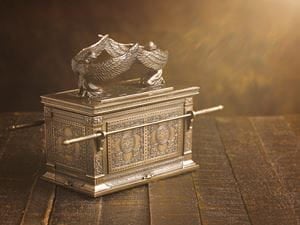
From pastors to parishioners, apologists to eschatologists, and billions of Christians, Muslims, and Jews worldwide, there are few sacred artifacts more revered and studied than the Ark of the Covenant. Also known as the "Ark of the Testimony" (Aron Ha-Edut {ארון העדות} in Hebrew), this seat of holiness is first mentioned in the Book of Exodus, Chapter 25.
The Bible describes the Ark of the Covenant as a sacred artifact crafted under God’s instructions to house the Ten Commandments, yet its final location remains a mystery following its last known placement in Solomon's Temple, with theories ranging from divine concealment to its possible relocation to Ethiopia.
The Ark of the Covenant was built during Moses' 40 days on Mount Sinai. The Spirit of the Lord provided detailed instructions for constructing this beacon of God’s presence, including the materials to use and who should build it. In Exodus 31, God led Moses to two master craftsmen, Bezalel and Oholiab—one from the tribe of Judah and the other from the tribe of Dan, respectively.
"I have filled him with the Spirit of God in wisdom, in understanding, in knowledge, and in all kinds of craftsmanship, to make artistic designs for work in gold, in silver, and in bronze, and in the cutting of stones for settings, and in the carving of wood, that he may work in all kinds of craftsmanship."
God provided Bezalel's qualifications in verses 2-5. In verse 6, God appointed Oholiab, the son of Ahisamach of the tribe of Dan, as Bezalel’s assistant. With these two skilled builders, Moses had his project team. Then, God provided a list of materials and specific instructions in Exodus 37 that any general contractor would appreciate.
Covered in gold and crafted with acacia wood, the Ark was the sacred resting place for the Ten Commandments. Using today’s conversion, with one cubit equal to approximately 1.5 feet, the Ark was around 3.75 feet long, 2.25 feet wide, and 2.25 feet high. It was ornate and extravagant—a priceless creation (though a movie prop in Raiders of the Lost Ark was valued between $80,000 and $250,000).
Following its final known resting place inside King Solomon’s temple in 586 BCE, the fate of the sacred Ark became uncertain after the Babylonian captivity.
Biblical Context of the Ark
The last mention of the Ark of the Covenant in the Bible before John’s vision in Revelation 11:19 is in 2 Chronicles 35:3:
"Then he said to the Levites who taught all Israel, who were holy to the Lord: 'Put the holy ark in the house which Solomon the son of David, king of Israel, built. It shall no longer be a burden on your shoulders. Now serve the Lord your God and His people Israel.'" (2 Chronicles 35:3, NKJV)
This occurred during Josiah’s reign, estimated by historians to be around 622 BCE. Four decades later, King Nebuchadnezzar's Babylonian armies invaded Israel twice, ultimately burning the city to ashes (2 Kings 24, NKJV).
Did the Babylonian king disregard such a precious artifact? Did the Levitical priests hide the Ark to protect it from the invading forces? These questions remain unanswered. Some scholars, citing Hebrews 9:20-25, suggest that the Ark John saw in his vision wasn’t the earthly Ark but a heavenly one.
"It was necessary, then, for the copies of the heavenly things to be purified with these sacrifices, but the heavenly things themselves with better sacrifices than these. For Christ did not enter a sanctuary made with human hands that was only a copy of the true one; he entered heaven itself, now to appear for us in God’s presence."
The reference to "copies of heavenly things" implies that the Ark seen in John's vision might have been the true Ark in heaven, while the earthly one remained lost.
Some other biblical references to the Ark of the Covenant include:
- Ezekiel 10:4-18, where the prophet spoke of the “Glory of the Lord” departing between the Cherubim during Jeconiah’s exile in 593 BCE.
- Lamentations 2:1 refers to God's "Footstool" (Chronicles 28:2, NKJV) not being remembered during the fall of Jerusalem, suggesting it was "abandoned."
Other Theories About the Ark
The most popular theory, albeit often debunked, is that the Ark was moved to a church in Aksum, Ethiopia, now known as St. Mary of Zion Cathedral. According to this theory, only one man, known as "the Guardian," is allowed to see it, and no one else is permitted to confirm its authenticity.
Another theory, mentioned in the deuterocanonical book of 2 Maccabees 2:1-8, suggests that the prophet Jeremiah hid the Ark in a cave, intending for Moses to retrieve it before his death.
However, those who hid the Ark reportedly failed to mark the location, and it was lost. Many theologians believe that God does not want the Ark to be found now that Jesus Christ has risen and fulfilled all the Ark symbolized.
This perspective is rooted in Jeremiah 3:16: "And when you shall be multiplied and increase in the land, saith the Lord, they shall say no more: 'The ark of the covenant of the Lord'; neither shall it come upon the heart, neither shall they remember it, neither shall it be visited, neither shall that be done anymore." (Jeremiah 3:16, DRA)
The Ark of the Covenant was a divine concept, a holy place, but it is not equivalent to the Cross of Calvary. There were no superpowers within the structure itself, but Christ’s redeeming power, displayed on the Cross, has bought our lives.
Although the Ark was a magnificent artifact built by Moses, Bezalel, and Oholiab under God’s direction, it held two tablets of stone.
Today, we have access to something greater—the everlasting masterpiece of Christ's resurrection, a truth we can revisit anytime.

